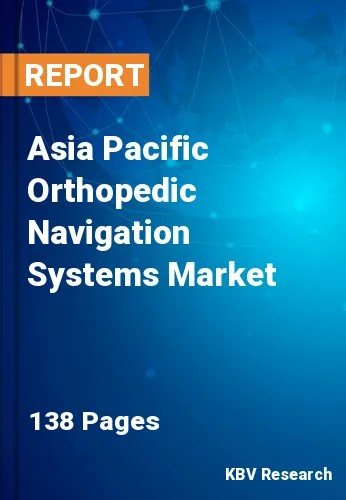The Asia Pacific Orthopedic Navigation Systems Market would witness market growth of 13.1% CAGR during the forecast period (2023-2030).
Orthopedic navigation systems utilize advanced imaging technology and intraoperative navigation, offering surgeons real-time, high-resolution imaging of the spinal anatomy. This guidance allows for accurately identifying the specific vertebrae and the trajectory for screw placement, significantly enhancing accuracy. The complex nature of spinal anatomy, especially during minimally invasive procedures, demands precise visualization. Navigation systems provide a clear view of the patient's spinal structures, assisting surgeons in identifying anatomical landmarks and aiding in accurate screw placement.
Moreover, in orthopedic trauma, navigation systems help in the accurate alignment and fixation of fractures and dislocations. These systems are particularly beneficial in multiple fractures or complex anatomical structures. Surgeons use navigation systems to visualize and navigate the joint space, ensuring optimal results. For patients who require revision surgeries due to implant failures or complications, these navigation systems play a crucial role in guiding surgeons to correct alignment and positioning issues from previous surgeries. These navigation systems are widely used in sports medicine to address injuries and conditions in athletes. These systems help repair ligaments, tendons, and cartilage with the highest degree of precision.
As per the data published by the National Investment Promotion and Facilitation Agency of India, the hospital industry in India, which accounts for 80% of the entire healthcare sector, is experiencing high investment demand from international and domestic investors. The hospital business is expected to rise to $132 billion by 2023. Furthermore, the medical tourism sector in India was anticipated to be around $5-6 billion in 2020 and is expected to increase to $13 billion by 2026. Thus, the rising healthcare investment and aging population in the Asia Pacific will help in the expansion of the regional market.
The China market dominated the Asia Pacific Orthopedic Navigation Systems Market by Country in 2022 and would continue to be a dominant market till 2030; thereby, achieving a market value of $358.4 Million by 2030. The Japan market is registering a CAGR of 12.4% during (2023 - 2030). Additionally, The India market would showcase a CAGR of 13.8% during (2023 - 2030).
Based on End-use, the market is segmented into Hospitals, and Ambulatory Surgical Centers. Based on Application, the market is segmented into Knee, Hip, and Spine. Based on Technology, the market is segmented into Optical, Electromagnetic, and Others. Based on countries, the market is segmented into China, Japan, India, South Korea, Singapore, Malaysia, and Rest of Asia Pacific.
Free Valuable Insights: The Global Orthopedic Navigation Systems Market is Predict to reach $5.5 Billion by 2030, at a CAGR of 12.2%
The market research report covers the analysis of key stake holders of the market. Key companies profiled in the report include B. Braun Melsungen AG, Stryker Corporation, Medtronic PLC, Smith & Nephew PLC, Johnson & Johnson, Zimmer Biomet Holdings, Inc., Vuzix Corporation, Kinamed Inc., Globus Medical, Inc. and Exactech, Inc.
By End-use
By Application
By Technology
By Country
Our team of dedicated experts can provide you with attractive expansion opportunities for your business.

